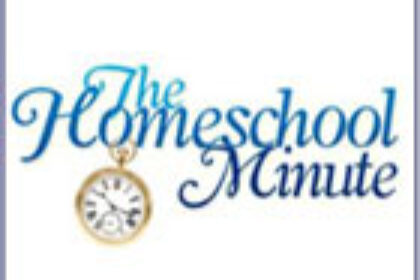A Moment with The Homeschool Minute ~ Mercy Every Minute – Deborah Wuehler, TOS Senior Editor

Click on the banner below to sign up for the Homeschool Minute E-Newsletter, and receive weekly encouragement to guide you along your homeschooling journey.
 I just finished telling my kids how I used to jump out of bed in the morning, get dressed, and race out the door to catch the bus or walk to school. I had no breakfast, no packed lunch, and often no jacket or umbrella. I was never prepared. My body was wide awake by the time I got to school, but my brain was still dozing. Sit down, open the books, listen, write–the end. I slogged through each day just waiting to get HOME so I could rest and eat and just be myself.
I just finished telling my kids how I used to jump out of bed in the morning, get dressed, and race out the door to catch the bus or walk to school. I had no breakfast, no packed lunch, and often no jacket or umbrella. I was never prepared. My body was wide awake by the time I got to school, but my brain was still dozing. Sit down, open the books, listen, write–the end. I slogged through each day just waiting to get HOME so I could rest and eat and just be myself.
Looking back, the troublemakers weren’t really troublemakers, they were just boys who needed to move, wiggle and DO something . . . and the girls just needed to talk and relate and move and create. My children get to do all of that and not be called troublemakers, but rather respected individuals and hands-on, real-life learners.
They can take their math up to the fort or outside to the picnic bench and enjoy their work with a snack. They can open the art cabinet and pull out any type of project material and be creative anytime they would like. (I almost always say yes to creativity.) They get the sleep and the nutrition they need.
Today, they sat and watched the little birds in our pine tree and identified them as nuthatches. Never would have happened in my schools, not even in the Christian schools I attended. Hands-on learning is the opposite of what traditional school offers children.
Hands-on learning is doing things like lapbooks and drama and unit studies, playing games, and taking nature walks. Hands-on is art work for grandma and treats for the neighbors or sewing and beading and paper crafting. Hands-on is gardening or raising fish or lizards or sea monkeys. Hands-on is knitting hats for orphanages or entering rabbits in county fairs. Hands-on is collecting leaves or flowers or insects or rocks and identifying them all with field guides.
Your children will have far better memories and greater learning capabilities by all the hands-on learning you are doing in your home environment—much more than anything your own boring school days did for you.
In case you needed a reminder, you are doing what is best for your children by keeping them Home Where They Belong.
~ Deborah
P.S. Friends, would you take a minute and let us know what you think of the magazine:
- What is your favorite part of The Old Schoolhouse® Magazine?
- Who is your favorite author?
- If you could just read three articles per issue of the magazine, which ones would they be?
- What subject would you like to see covered in the future?
Email your answers to dwuehler@thehomeschoolmagazine.com If you haven’t read it yet this month, you can always find the most current issue here: www.TOSMagazine.com
|
Sponsor Article
MAKING LITERATURE HANDS-ON, SENSORY, AND FUN!
Relating to a great book in fun, multisensory ways helps kids effortlessly absorb the important stuff we all know is packed in literature. Better yet, it makes kids want to read more great books!
When kids taste, touch, hear, and smell the story, it gets up off the page and becomes more real to them. Participating in characters’ experiences, handling interesting items, listening to traditional music , recreating objects, and dining on food from the book are ways of bringing that other world up close.
When we do activities that lead us to deeper meanings within a story, we help kids learn discernment and develop their intuition. There’s lifelong value in the ability to notice patterns, connect meanings, and read between the lines.
When we bring cultural allusions into three dimensions, we help kids understand them and feel included in society. They learn that literature lets them in on the references made by adults, and they gain confidence from being well-read.
When we engage kids in projects, such as artistically enhancing a scene or recreating an important item, the book and its lessons are much more memorable.
When we help kids connect with the author’s world, they grasp the ideas of context and influence that are key to developing critical thinking skills. When we use sensory clues to help kids spot connections between the author’s life and book, they see that a book represents a real person. It’s a level of awareness they’ll draw on as they develop their own power to impart their beliefs on a page.
Books, after all, are not about words but experiences of action and being. By joining the characters in their experiences, kids connect with great books–and want to read more.
Jenny Clendenen Walicek and Becky Clendenen Walicek are sisters and partners in LitWits Workshops. LitWits brings great books to life, so kids will want to read more! We offer:
For a FREE GIFT, sign up for Tips & Updates about great books and enrichment ideas! To purchase a guide at 50% OFF, visit the Guides store and enter code TOS2013 upon checkout. |

























